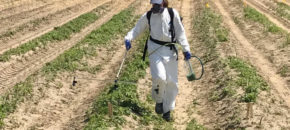
Paraquat is an herbicide labeled on various crops species for row middles applications. However, with new paraquat use restrictions in place, vegetable growers may be interested by other herbicide options available for controlling emerged weed seedlings. Paraquat controls numerous annual grasses and broadleaf weeds seedlings by inhibiting plant photosynthesis. Its acts quickly by contact when […]
Continue reading...
